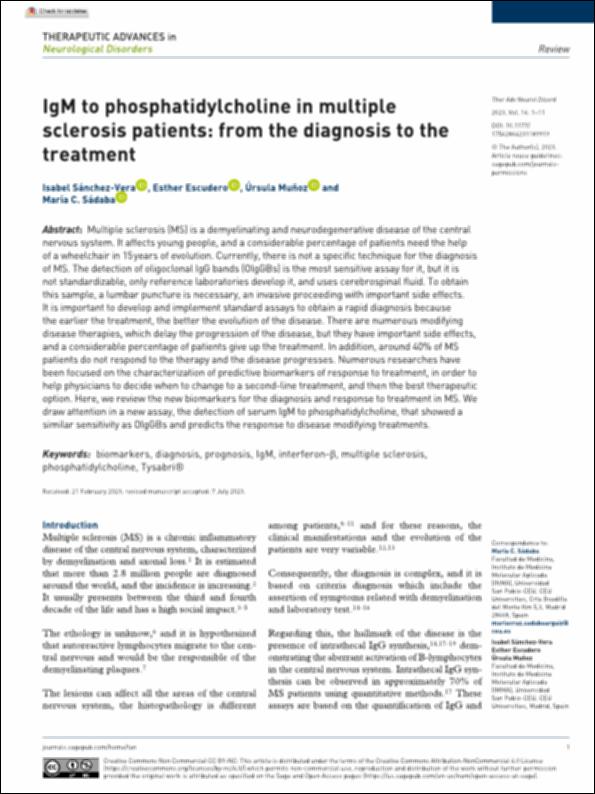Please use this identifier to cite or link to this item:
http://hdl.handle.net/10637/15449IgM to phosphatidylcholine in multiple sclerosis patients: from the diagnosis to the treatment
| Title: | IgM to phosphatidylcholine in multiple sclerosis patients: from the diagnosis to the treatment |
| Authors : | Sánchez Vera, Isabel Escudero Lirola, Esther Muñoz Morón, Úrsula Sádaba Argaiz, María Cruz |
| Keywords: | Biomarkers; Diagnosis; Prognosis; IgM; Interferon-β; Multiple sclerosis; Phosphatidylcholine; Tysabri® |
| Publisher: | SAGE Publications |
| Citation: | Sánchez-Vera I, Escudero E, Muñoz Ú, Sádaba MC. IgM to phosphatidylcholine in multiple sclerosis patients: from the diagnosis to the treatment. Therapeutic Advances in Neurological Disorders. 2023;16. doi:10.1177/17562864231189919 |
| Abstract: | Multiple sclerosis (MS) is a demyelinating and neurodegenerative disease of the central nervous system. It affects young people, and a considerable percentage of patients need the help of a wheelchair in 15 years of evolution. Currently, there is not a specific technique for the diagnosis of MS. The detection of oligoclonal IgG bands (OIgGBs) is the most sensitive assay for it, but it is not standardizable, only reference laboratories develop it, and uses cerebrospinal fluid. To obtain this sample, a lumbar puncture is necessary, an invasive proceeding with important side effects. It is important to develop and implement standard assays to obtain a rapid diagnosis because the earlier the treatment, the better the evolution of the disease. There are numerous modifying disease therapies, which delay the progression of the disease, but they have important side effects, and a considerable percentage of patients give up the treatment. In addition, around 40% of MS patients do not respond to the therapy and the disease progresses. Numerous researches have been focused on the characterization of predictive biomarkers of response to treatment, in order to help physicians to decide when to change to a second-line treatment, and then the best therapeutic option. Here, we review the new biomarkers for the diagnosis and response to treatment in MS. We draw attention in a new assay, the detection of serum IgM to phosphatidylcholine, that showed a similar sensitivity as OIgGBs and predicts the response to disease modifying treatments. |
| URI: | http://hdl.handle.net/10637/15449 |
| Rights : | http://creativecommons.org/licenses/by-nc-nd/4.0/deed.es OpenAccess |
| ISSN: | 1756-2864 |
| Issue Date: | 17-Aug-2023 |
| Center : | Universidad San Pablo-CEU |
| Appears in Collections: | Medicina |
Items in DSpace are protected by copyright, with all rights reserved, unless otherwise indicated.


